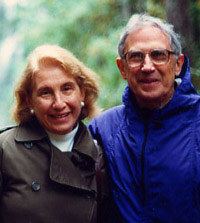

[Note: My father delivered this eulogy at Enid's funeral on October 3, 2008. - Peter]
Enid and I were married the Sunday following her graduation from Smith College in June of 1954. Enid was visiting with her cousins, actually her step-mother’s nieces during spring vacation of 1953. This was the era when a young daughter could not be left alone in a New York apartment when her parents vacationed. A friend of mine, who was engaged to the older cousin, called and wangled me into meeting Enid. That first date was a drive to Atlantic City with the engaged couple and dinner at the long gone Shelburne Hotel. I was smitten.
We went out again and then the summer rolled around and Enid left on a European trip with a girl friend. Can you imagine the aggravation? But I had her itinerary and there was a letter waiting for her at the American Express office at her every stop. When she finally returned, I hastened over to NYC and proposed to her at dinner. She said ‘yes.’ It was our third date.
When she was nine Enid attended Camp Lenore. On parents’ visiting day, the arts and crafts counselor showed her folks her drawings and noted her skill. After camp she was promptly enrolled in the Saturday morning art classes at the Brooklyn Museum.
Her Mom gave her nickels for the subway (only a nickel and perfectly safe in those years) and told her not to get lost because she didn’t even know where Brooklyn was and would never be able to find her. This was the beginning that led Enid into the world of art. What do you know? It was OK for a nine-year old to navigate the subway system but not for a 21 year old to stay in a doorman protected city apartment alone!
One can call it serendipity or the Smith College network that led Enid into the world of books. Sylvia Plath was a classmate and a close friend. Regrettably Sylvia was hospitalized probably after their junior year. Enid had saved a few letters from Sylvia, some contained poetry that Sylvia had written to Enid. On the occasion of Enid’s 25th reunion, Enid mailed three surviving letters to the Smith College Rare Book Room. This story is fully detailed in a memoir Enid wrote in About Sylvia. And this truly led to Enid’s entry into the book world. A Smith friend, actually a casual friend one class ahead, had become the Curator of Rare Books in the Smith College Library. When Ruth Mortimer saw those letters emerge from an ordinary envelope uninsured, she must have been stunned. This gift became the nucleus of the huge Sylvia Plath archive in the Library’s holdings. Ruth Mortimer had established her bona fides while at the Houghton Rare Book Library at Harvard by researching Italian and French 15th and 16th century books and publishing the bibliography in two magnificent volumes, either of which would merit a Ph D. At any rate, Ruth collected literary allusions and metaphors, mainly poetry, to thread and weaving.
Coincidentally, Enid was creating prints that involved weaving. While en route to Baltimore, Ruth stopped to see a Philadelphia gallery’s show of this group of ‘woven’ prints. She suggested promptly that they collaborate on an artist’s book based on Ruth’s collection and Enid’s images. Enid was hooked.
But, to collaborate with Ruth Mortimer, this brilliant star in the rare book world, required that Enid gain knowledge of fine letterpress printing, hand set typography, fine papers, hand lithography and hand bookbinding. Three or four years later The Bewildering Thread was published. Enid had entered the Rare Book World.
There was a humorous side to this story. Enid had labored for a year and a half to produce this book. Ruth suggested the curators of a number of collections as possible purchasers. When Enid called, their immediate reaction was, “Ruth’s book … of course we want it!”
In a nutshell this is the story of how we met, how her talent was discovered, and how she entered the world of books.
After 54 years of a wonderful marriage, with the fondest of memories, I am grateful for those years, but I will always wonder why it was destined not to last longer.
Sweet dreams, my Sweet Heart.
Eugene L. Mark